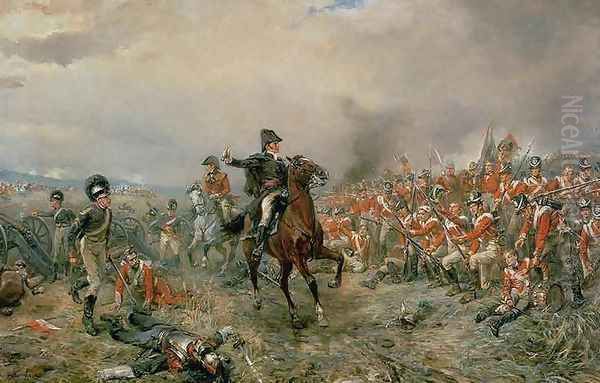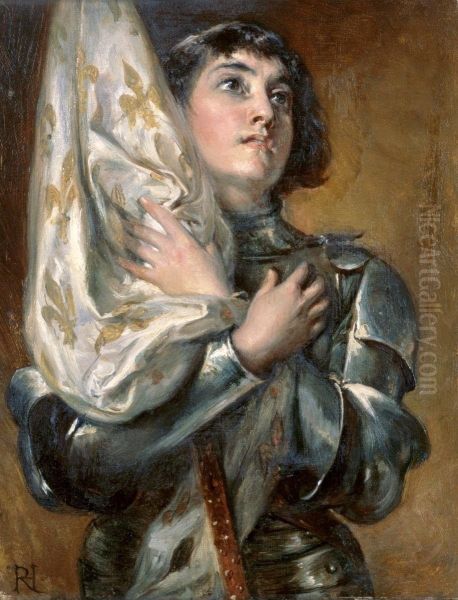Robert Alexander Hillingford stands as a notable figure within the landscape of 19th-century British art. Born in London on January 28, 1828, and passing away in 1904, his life spanned a period of significant change and development in artistic styles and tastes. Hillingford carved a distinct niche for himself as a painter of historical and literary scenes, becoming particularly renowned for his detailed and dramatic depictions of the Napoleonic Wars, capturing the imagination of the Victorian public.
His dedication to the historical genre placed him among the successful painters of his era, navigating the expectations of the Royal Academy and the broader art market. While perhaps not as revolutionary as some contemporaries, his work provides a valuable window into Victorian interpretations of the past and the enduring appeal of historical narratives in art.
Early Life and Continental Training
Hillingford's artistic journey began at a remarkably young age. When he was just thirteen, around 1841, he left England to study in Düsseldorf, Germany. This city was a significant art centre, known for the Düsseldorf School of painting which emphasized detailed realism and narrative clarity, often applied to historical and landscape subjects. This early exposure likely played a role in shaping his meticulous approach.
In Düsseldorf, he entered the prestigious Kunstakademie (Art Academy) and studied under the guidance of Professor Karl Ferdinand Sohn, a respected figure within the German academic tradition. Hillingford spent five years honing his skills in this environment before moving on to Munich, another important artistic hub in Germany, further broadening his European artistic education.
His formative years were also marked by extensive travel through Italy, a crucial destination for artists seeking inspiration from classical antiquity and the Renaissance masters. He visited major centres of art and history, including Rome, Florence, Naples, and Perugia. This immersion in Italian art and culture undoubtedly enriched his visual vocabulary and understanding of historical representation, providing him with a wealth of visual and thematic material for his future work.
Establishing a Career in Historical Painting

Upon returning to England, Hillingford established himself as a professional artist. He focused his talents primarily on historical subjects, a genre highly regarded within the academic tradition of the time. His meticulous training in Germany and his travels in Italy equipped him well for the demands of historical painting, which required careful research into costumes, settings, and historical accuracy, combined with the ability to construct compelling narrative compositions.
His dedication and skill earned him recognition within the London art world. Between 1864 and 1902, Hillingford exhibited a significant body of work, totalling 29 paintings, at the prestigious Royal Academy of Arts annual exhibitions. This consistent presence at the RA, the epicentre of the British art establishment, cemented his reputation and brought his work to a wide audience. He also exhibited works at other venues, including the Royal Society of British Artists in Suffolk Street.
Hillingford became known as a successful Victorian painter, adept at capturing moments of historical drama and significance. His paintings often depicted scenes laden with detail, aiming to transport the viewer back to a specific moment in time, whether a grand military event or a poignant scene from literature.
The Napoleonic Wars: A Defining Theme
While Hillingford tackled various historical and literary subjects, he became particularly associated with depictions of the Napoleonic Wars (1803-1815). This period of intense European conflict, culminating in the Battle of Waterloo, held a powerful grip on the British imagination throughout the 19th century. Hillingford tapped into this interest, creating numerous works that explored different facets of the era.
His paintings often focused on key figures and moments, particularly involving the British perspective and the Duke of Wellington. These works were characterized by their attention to military detail – uniforms, weaponry, and the chaos of battle – combined with a sense of narrative drama. He aimed to convey not just the facts of the event, but also the human experience within it.
Unlike French artists such as Jacques-Louis David or Antoine-Jean Gros, who often glorified Napoleon in monumental canvases during or shortly after the Emperor's reign, Hillingford's perspective was naturally filtered through a British Victorian lens, often highlighting British resilience and leadership, particularly that of Wellington.
Notable Works: Capturing History and Literature

Several specific paintings exemplify Hillingford's focus and style. Among his most famous works related to the Napoleonic Wars is Wellington at Waterloo (also referred to as The Duke of Wellington at Waterloo). This painting captures a pivotal moment during the decisive battle, likely depicting the Duke directing his troops amidst the smoke and turmoil of the conflict. Such works resonated with national pride and the enduring legacy of the victory.
Another significant work is The Duke of Wellington in Portugal, 1809. This piece shifts the focus from the climax of Waterloo to an earlier campaign, showcasing Wellington's strategic command during the Peninsular War. The painting is noted for its detailed background and careful rendering of the figures, illustrating Hillingford's commitment to historical setting.
Hillingford also depicted the social side of the conflict, as seen in The Dance of the Duchess of Richmond, painted in the 1870s. This work references the famous ball held in Brussels on the eve of the Battle of Quatre Bras (and shortly before Waterloo), an event imbued with dramatic irony as festivities gave way to war. It allowed Hillingford to explore period costume and social dynamics alongside the looming military drama.
Beyond the Napoleonic era, Hillingford addressed other historical subjects. The Siege of Oxford likely depicted an event from the English Civil War, another period rich in dramatic potential for historical painters. His repertoire also included literary scenes, such as Othello and Desdemona, drawing inspiration from Shakespeare, a perennial favourite among Victorian artists including many associated with the Pre-Raphaelite Brotherhood. Religious or heroic figures also featured, as evidenced by a work depicting Joan of Arc.
He occasionally ventured into genre painting, capturing scenes of contemporary life or leisure. A Break in the Game, an oil painting from the 19th century, offers a fascinating glimpse into social history, depicting women participating in cue sports like billiards or snooker, possibly marking a moment of changing social norms.
Artistic Style: Detail, Narrative, and Debate
Hillingford's artistic style was firmly rooted in the academic traditions he absorbed during his training. His work is characterized by a high degree of finish, meticulous attention to detail, and a strong emphasis on narrative clarity. He excelled at rendering textures, fabrics, architectural elements, and the specific accoutrements of historical periods, particularly military uniforms and equipment.
His compositions are typically well-structured, designed to clearly convey the story or historical moment being depicted. Figures are carefully drawn and grouped to create dramatic focus and interaction. The use of colour is generally rich and representative, serving the overall goal of realistic depiction rather than purely expressive effect.
This commitment to detail and historical accuracy was a hallmark of much Victorian historical painting. However, it also led to some contemporary criticism. Some commentators felt that Hillingford's intense focus on accuracy and minute detail occasionally came at the expense of deeper emotional expression or artistic dynamism. This reflects a broader debate within 19th-century art regarding the balance between faithful representation (mimesis) and artistic interpretation or emotional impact. His approach contrasted with the burgeoning Impressionist movement, which prioritized capturing fleeting moments and light over precise detail, and also differed from the intense symbolism and stylization favoured by artists like Dante Gabriel Rossetti.
Hillingford in the Context of Victorian Art
To fully appreciate Hillingford's position, it's helpful to place him within the broader context of the Victorian art world. He operated during a time dominated by the Royal Academy, which championed historical painting, portraiture, and genre scenes executed with technical proficiency. Hillingford clearly met these standards, achieving considerable success within the established system.
His focus on historical narrative aligned with the interests of painters like William Powell Frith, known for his sprawling canvases of modern life like Derby Day, or Lawrence Alma-Tadema, who specialized in meticulously researched scenes of classical antiquity. While their subjects differed, they shared a commitment to detailed realism and storytelling that appealed to Victorian audiences.
In the specific field of military and battle painting, Hillingford worked alongside contemporaries such as Ernest Crofts and Lady Butler (Elizabeth Thompson), who also gained fame for their depictions of British military history, often focusing on the Napoleonic Wars or more recent conflicts like the Crimean War. They shared an interest in capturing the drama and human element of warfare.
Interestingly, while Hillingford was active during the height of the Pre-Raphaelite Brotherhood and its influence, the provided information suggests no direct documented connection or interaction. The Pre-Raphaelites, including figures like John Everett Millais, William Holman Hunt, and Dante Gabriel Rossetti, initially rebelled against academic conventions, seeking inspiration in early Italian art and emphasizing intense detail, vibrant colour, and often complex symbolism drawn from literature and religion. While Hillingford shared an interest in literary themes and detailed rendering, his overall style remained more aligned with mainstream academic practice than with the specific tenets and aesthetics of the PRB. His contemporaries also included figures moving towards Aestheticism, like Edward Poynter, whose focus shifted more towards beauty and classical form.
Some sources hint at possible later stylistic shifts in Hillingford's work, potentially influenced by Impressionism, leading to paintings focused on rural life, such as harvesting scenes. If accurate, this would suggest an artist adapting to changing tastes later in his career, although his primary reputation remains firmly tied to his historical canvases.
Legacy and Conclusion
Robert Alexander Hillingford occupies a solid place in the annals of British Victorian art. He was a highly skilled and dedicated historical painter who specialized in bringing moments from the past, particularly the Napoleonic Wars, vividly to life for his contemporaries. His work satisfied the Victorian appetite for narrative, detail, and historical reflection, particularly concerning Britain's military past.
His paintings, characterized by meticulous research, careful composition, and dramatic flair, earned him recognition at the Royal Academy and a successful career. While subject to the ongoing art historical debates about accuracy versus expression, his canvases remain valuable documents of how the Victorian era viewed and visualized history. He contributed significantly to the genre of historical painting in Britain, leaving behind a body of work that continues to offer insights into the conflicts, figures, and stories that shaped 19th-century consciousness. His legacy is that of a chronicler in paint, preserving moments of history through the lens of Victorian artistry.